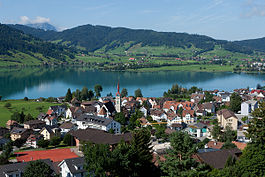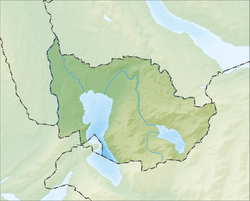Oberägeri
| Oberägeri | |
|---|---|
 |
|
| Coordinates: 47°8′N 8°36′E / 47.133°N 8.600°ECoordinates: 47°8′N 8°36′E / 47.133°N 8.600°E | |
| Country | Switzerland |
| Canton | Zug |
| District | n.a. |
| Government | |
| • Mayor | Pius Meier |
| Area | |
| • Total | 30.03 km2 (11.59 sq mi) |
| Elevation | 737 m (2,418 ft) |
| Population (Dec 2015) | |
| • Total | 5,940 |
| • Density | 200/km2 (510/sq mi) |
| Postal code | 6315 |
| SFOS number | 1706 |
| Surrounded by | Einsiedeln (SZ), Feusisberg (SZ), Hütten (ZH), Menzingen, Rothenthurm (SZ), Sattel (SZ), Unterägeri |
| Website |
www SFSO statistics |
Oberägeri, until 1798 simply known as Ägeri, is a municipality in the canton of Zug in Switzerland.
Oberägeri is first mentioned in 1150 as Agregia. In 1538 it was mentioned as Ober Egere.
The first church in the valley was built in 876. After 1100, the land belonged to the monastery on Einsiedeln, and was influenced by the Battle of Morgarten.
The Battle of Morgarten occurred on 15 November 1315 at Morgarten (now part of Oberägeri) and near neighboring Sattel. It began when a Swiss Confederation force of 1,500 infantry archers ambushed a group of Austrian soldiers of the Holy Roman Empire near the Morgarten Pass. The Swiss, led by Werner Stauffacher, thoroughly defeated the Austrians, who were under the command of Duke Leopold I of Austria.
The Confederates prepared a road-block and an ambush at a point between Lake Aegeri and Morgarten pass where the small path led between the steep slope and a swamp. When about 1500 men attacked from above with rocks, logs and halberds, the knights had no room to defend themselves and suffered a crushing defeat, while the foot soldiers in the rear fled back to the city of Zug. A chronicler described the Confederates, unfamiliar with the customs of battles between knights, as brutally butchering everything that moved and everyone unable to flee. This founded the reputation of the Confederates as barbaric, yet fierce and respectable fighters.
Within a month of the battle, in December 1315, the Confederates renewed the oath of alliance made in 1291, initiating the phase of growth of the Old Swiss Confederacy. Within forty years, cities including Lucerne, Zug, Zürich and Bern had joined the confederation.
...
Wikipedia



